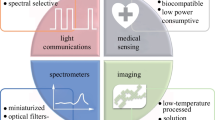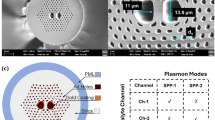Abstract
3D interference fringe pattern recognition using a plasmonic sensing circuit is proposed. The plasmonic sensing in the form of a panda ring comprises an embedded gold grating at the microring center. WGM (whispering gallery mode) is observed at the microring center with suitable parameters. The dark soliton of 1.50 µm wavelength excites the gold grating which leads to electron cloud oscillation and forms the electron densities where the trapped electrons inside the silicon microring are transported via wireless connection using WGM and cable connection. The spin down \(\left| \downarrow \right\rangle\left( {\left| 1 \right\rangle } \right)\) and spin up \(\left| \uparrow \right\rangle\left( {\left| 0 \right\rangle } \right)\) result from the electron cloud oscillation. By using the changes in gold lengths, the excited electron pattern recognition can be manipulated, where the values “0” and “1” are useful for pattern recognition. The fringe patterns of the plasmonic interferometric sensor are recorded, which means that the novel 3D pattern recognition can be possibly implemented and used in many applications. Therefore, the plasmonic sensing circuit can be used to form the quantum code, quantum encryption, quantum sensor, and pattern recognition.




Similar content being viewed by others
References
Bakhtiar LA, Hosseinzadeh M (2016) All optical residue arithmetic with micro ring resonators and its application. Opt Quant Electron J 48(125):1–13
Bhnassy MA, Hagras EAA, El-Badawy EA et al (2019) Image encryption and watermarking combined dynamic chaotic hopping pattern with double random phase encoding DRPE. Opt Quant Electron J 51(246):1–18
Farrokhi CZ, Bahrami A, Mohammadnejad S (2015) MMI-based all optical multi-input XOR and XNOR logic gates using nonlinear directional coupler. Opt Quant Electron J 47:3477–3489
Hong W, Wang J, Li W (2019) CSK hopping pattern model for visible light communication networks. Opt Quant Electron J l 51(108):1–17
Imtiaz WA, Ahmed HY, Zeghid M et al (2020) Two dimensional optimized enhanced multi diagonal code for OCDMA passive optical networks. Opt Quant Electron J 52(33):1–17
Jordovic-Pavlovic MI, Kupusinac AD, Djordjevic KL et al (2020) Computationally intelligent description of a photoacoustic detector. Opt Quant Electron J 52(246):1–21
Kotb A, Guo C (2019) All optical NOR and XNOR logic gates at 2Tb/s based on two-photon absorption in quantum-dot semiconductor optical amplifiers. Opt Quant Electron J 52(30):1–19
Kumar A (2016) Application of micro-ring resonator as high speed optical gray code converter. Opt Quant Electron J 48(460):1–14
Kumar A, Kumar M, Jindal SK et al (2019) Implementation of all optical active low/high tri-state buffer logic using the micro-ring resonator structures. Opt Quant Electron J 51(191):1–18
Liu J, Mao L, Ku J et al (2016) THz spectroscopy detection method for GMOs based on adaptive particle swarm optimization. Opt Quant Electron J 48(167):1–9
Maity GK, Mandal AK, Manik NB et al (2016) All optical TOAD based new binary sequence generator. Opt Quant Electron J 48(329):1–15
Metya SK, Janyani V (2015) Improved dispersion tolerance of Miller coding by integrating duobinary coding. Opt Quant Electron J 47:125–130
Morsy MA, Alsayyari AS (2019) Multi rate OCDMA system BER performance evaluations for different ML-code sequences. Opt Quant Electron J 51(198):1–18
Mu Y, Jiang J, Ding N et al (2019) A 7.4 kHz, 20-bit image encoder with a CMOS linear image sensor. Opt Quant Electron J 51(321):1–13
Phatharacorn P, Chiangga S, Yupapin P (2016) Analytical and simulation of a triple micro whispering gallery mode probe system for a 3D blood flow rate sensor. Appl Opt 55:9504–9513
Salehi MR, Dehyadegari L (2016) Nanophotonic reservoir computing for noisy speech recognition. Opt Quant Electron J 48(281):1–18
Si C, Yan Y (2015) Discriminative local difference patterns for robust face recognition. Electron Lett 51(25):2108–2109
Soliman RF, Amin M, Abd EL-Samie FE (2018) A double random phase encoding approach for cancelable iris recognition. Opt Quant Electron J 50(326):1–12
Zhaohui M, Xiaodong G (2013) Hand vein recognition using local block pattern. Electron Lett 49(25):1614–1615
Kowsari A, Saghaei H (2018) Resonantly enhanced all-optical switching in microfiber Mach-Zehnder interferometer. Electro Lett 54(4):229–231
Arumona AE, Amiri IS, Punthawanun S et al (2020) 3D quantum interferometer using silicon microring embedded gold grating circuit. Microscopy and Research Technique 83(10):1217–1224
Agrawal GP (2011) Nonlinear fiber optics: its history and recent progress [Invited]. J Opt Soc Am B 28(12):A1–A10
Szuatakowski M, Palka N (2005) Contrast sensitive fiber optic Michelson interferometer as elongation sensor. Opto-electron Rev 13(1):19–26
Tunsiri S, Thammawongsa N, Threepak T, Mitatha S, Yupapin P (2019) Microring switching control using plasmonic ring resonator circuits for super-channel use. Plasmonics 14:1669–1677
Pornsuwancharoen N, Amiri IS, Suhailin FH, Aziz MS, Ali J, Singh G, Yupapin P (2017) Micro-current source generated by a WGM of light within a stacked silicon-graphene-Au waveguide. IEEE Photon Technol Lett 29:1768–1771
OptiFDTD Technical Background and Tutorials (Finite Difference Time Domain) Photonics Simulation Software, Version 12.0. http://www.optiwave.com, Searched on 20th Sept, 2019.
Blaber MG, Arnold MD, Ford MJ (2009) Search for the ideal plasmonic nanoshell: the effects of surface scattering and alternatives to gold and silver. J Phys Chem C 113:3041–3045
Prabhu AM, Tsay A, Han Z, Van V (2010) Extreme miniaturization of silicon add-drop microring filters for VLSI photonics applications. IEEE Photonics J 2:436–444
Acknowledgements
The authors would like to acknowledge the research facilities from Ton Duc Thang University, Vietnam.
Author information
Authors and Affiliations
Contributions
Arumona Edward Arumona: simulation, analysis, and writing original draft; Anita Garhwal: MATLAB results improvement, review, and discussion; Phichai Youplao: validation, comparing Optiwave and MATLAB results, visualization, and discussion; Kanad Ray: modeling, analysis, discussion, and final editing; Wanchai Khunnam: improve the writing draft and discussion; Preecha Yupapin: conceptualization, supervision, review, editing, and submission. All authors have read through the manuscript.
Corresponding author
Ethics declarations
Competing Interests
The authors declare no competing interests.
Additional information
Publisher's Note
Springer Nature remains neutral with regard to jurisdictional claims in published maps and institutional affiliations.
Rights and permissions
About this article
Cite this article
Arumona, A.E., Garhwal, A., Youplao, P. et al. 3D Fringe Pattern Coding and Recognition Using Plasmonic Sensing Circuit. Plasmonics 16, 1955–1961 (2021). https://doi.org/10.1007/s11468-021-01460-3
Received:
Accepted:
Published:
Issue Date:
DOI: https://doi.org/10.1007/s11468-021-01460-3




